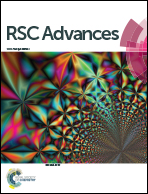Augmented biocontrol action of silica nanoparticles and Pseudomonas fluorescens bioformulant in maize (Zea mays L.)
Abstract
Nanosilica and Pseudomonas sp. was treated in soil to enhance the biocontrol activity against pathogens in maize. The leaf hardness shows an increase in surface roughness and elevated phenols while treating nanobiocomposites. Higher phenols and hardness induce silica accumulation in leaves and initiate more effective physical barriers for crop protection.


 Please wait while we load your content...
Please wait while we load your content...